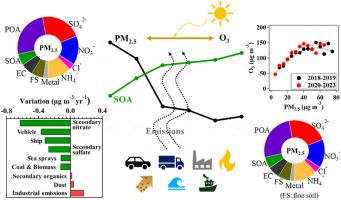2018-2023年珠三角中部地区PM2.5化学成分、来源变化趋势及其与臭氧的关系
IF 3.7
2区 环境科学与生态学
Q2 ENVIRONMENTAL SCIENCES
引用次数: 0
摘要
东莞是中国珠江三角洲中部的全球制造业中心和特大城市,在平衡空气质量改善与经济增长方面面临着挑战。PM2.5的动态变化及其与臭氧的协调性为空气质量决策提供了重要依据,并适用于全球其他快速发展的城市。本研究分析了2018年至2023年PM2.5组成、来源及其与臭氧相互作用的趋势。PM2.5及其无机组分(SO42−、NO3−和NH4+)在−0.57 ~−0.34 μ m−3 yr−1范围内显著下降(3.76 μ m−3 yr−1),而二次有机气溶胶(SOA)则相反增加(+0.18 μ m−3 yr−1)。来源分析显示,基于正矩阵分解(PMF)方法的二次有机因子也呈现上升趋势,但仍存在显著的不确定性。工业排放量逐年增加,增幅有统计学意义(+0.17 μg m−3 yr−1)。PM2.5与臭氧呈非线性关系,PM2.5低于40 μg m−3时,臭氧明显受到抑制,同时NO3−、NOx和NO2/NO比值升高。我们的研究结果强调,迫切需要控制二次污染物及其前体,如氮氧化物和挥发性有机化合物,特别是来自工业来源。本文章由计算机程序翻译,如有差异,请以英文原文为准。

Trend in chemical components and sources of PM2.5 and its relationship with ozone in central PRD, China (2018–2023)
Dongguan, a global manufacturing hub and megacity in the central Pearl River Delta (PRD), China, faces challenges in balancing air quality improvement with economic growth. The dynamic changes in PM2.5 and their coordination with ozone provide a crucial basis for air quality policy-making, and are applicable to other fast-developing cities worldwide. This study analyzed trends in PM2.5 composition, sources, and interactions with ozone from 2018 to 2023. While PM2.5 decreased significantly (3.76 μg m−3 yr−1) along with its inorganic components (SO42−, NO3− and NH4+, ranging from −0.57 to −0.34 μg m−3 yr−1), secondary organic aerosol (SOA) conversely increased (+0.18 μg m−3 yr−1). Source analysis revealed that a secondary organic factor based on the positive matrix factorization (PMF) method also showed a rising trend, although notable uncertainty remains. Industrial emissions increased annually with statistical significance (+0.17 μg m−3 yr−1). A non-linear relationship between PM2.5 and ozone was identified, with co-occurrence below 40 μg m−3 PM2.5 and apparent suppression of ozone above this threshold, accompanied by elevated NO3−, NOx and NO2/NO ratios. Our results highlight the urgent need to control secondary pollutants and their precursors such as NOx and VOCs, particularly from industrial sources.
求助全文
通过发布文献求助,成功后即可免费获取论文全文。
去求助
来源期刊

Atmospheric Environment
环境科学-环境科学
CiteScore
9.40
自引率
8.00%
发文量
458
审稿时长
53 days
期刊介绍:
Atmospheric Environment has an open access mirror journal Atmospheric Environment: X, sharing the same aims and scope, editorial team, submission system and rigorous peer review.
Atmospheric Environment is the international journal for scientists in different disciplines related to atmospheric composition and its impacts. The journal publishes scientific articles with atmospheric relevance of emissions and depositions of gaseous and particulate compounds, chemical processes and physical effects in the atmosphere, as well as impacts of the changing atmospheric composition on human health, air quality, climate change, and ecosystems.
 求助内容:
求助内容: 应助结果提醒方式:
应助结果提醒方式:


